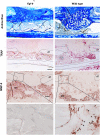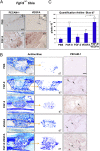Fgf-9 is required for angiogenesis and osteogenesis in long bone repair
- PMID: 20547837
- PMCID: PMC2900703
- DOI: 10.1073/pnas.1003317107
Fgf-9 is required for angiogenesis and osteogenesis in long bone repair
Abstract
Bone healing requires a complex interaction of growth factors that establishes an environment for efficient bone regeneration. Among these, FGFs have been considered important for intrinsic bone-healing capacity. In this study, we analyzed the role of Fgf-9 in long bone repair. One-millimeter unicortical defects were created in tibias of Fgf-9(+/-) and wild-type mice. Histomorphometry revealed that half-dose gene of Fgf-9 markedly reduced bone regeneration as compared with wild-type. Both immunohistochemistry and RT-PCR analysis revealed markedly decreased levels of proliferating cell nuclear antigen (PCNA), Runt-related transcription factor 2 (Runx2), osteocalcin, Vega-a, and platelet endothelial cell adhesion molecule 1 (PECAM-1) in Fgf-9(+/-) defects. muCT angiography indicated dramatic impairment of neovascularization in Fgf-9(+/-) mice as compared with controls. Treatment with FGF-9 protein promoted angiogenesis and successfully rescued the healing capacity of Fgf-9(+/-) mice. Importantly, although other pro-osteogenic factors [Fgf-2, Fgf-18, and bone morphogenic protein 2 (Bmp-2)] still were present in Fgf-9(+/-) mice, they could not compensate for the haploinsufficiency of the Fgf-9 gene. Therefore, endogenous Fgf-9 seems to play an important role in long bone repair. Taken together our data suggest a unique role for Fgf-9 in bone healing, presumably by initiating angiogenesis through Vegf-a. Moreover, this study further supports the embryonic phenotype previously observed in the developing limb, thus promoting the concept that healing processes in adult organisms may recapitulate embryonic skeletal development.
Conflict of interest statement
The authors declare no conflict of interest.
Figures





Similar articles
-
Fgf-18 is required for osteogenesis but not angiogenesis during long bone repair.Tissue Eng Part A. 2011 Aug;17(15-16):2061-9. doi: 10.1089/ten.TEA.2010.0719. Epub 2011 Jun 1. Tissue Eng Part A. 2011. PMID: 21457097 Free PMC article.
-
Application of VEGFA and FGF-9 enhances angiogenesis, osteogenesis and bone remodeling in type 2 diabetic long bone regeneration.PLoS One. 2015 Mar 5;10(3):e0118823. doi: 10.1371/journal.pone.0118823. eCollection 2015. PLoS One. 2015. PMID: 25742620 Free PMC article.
-
Osteoblast-derived EGFL6 couples angiogenesis to osteogenesis during bone repair.Theranostics. 2021 Sep 27;11(20):9738-9751. doi: 10.7150/thno.60902. eCollection 2021. Theranostics. 2021. PMID: 34815781 Free PMC article.
-
Micrornas at the Interface between Osteogenesis and Angiogenesis as Targets for Bone Regeneration.Cells. 2019 Feb 3;8(2):121. doi: 10.3390/cells8020121. Cells. 2019. PMID: 30717449 Free PMC article. Review.
-
Coupling of osteogenesis and angiogenesis in bone substitute healing - a brief overview.Ann Anat. 2012 Mar 20;194(2):171-3. doi: 10.1016/j.aanat.2011.10.002. Epub 2011 Oct 14. Ann Anat. 2012. PMID: 22055938 Review.
Cited by
-
The Effect of An Angiogenic Cytokine on Orthodontically Induced Inflammatory Root Resorption.Cell J. 2016 Jul-Sep;18(2):271-80. doi: 10.22074/cellj.2016.4323. Epub 2016 May 30. Cell J. 2016. PMID: 27551674 Free PMC article.
-
The roles of vascular endothelial growth factor in bone repair and regeneration.Bone. 2016 Oct;91:30-8. doi: 10.1016/j.bone.2016.06.013. Epub 2016 Jun 25. Bone. 2016. PMID: 27353702 Free PMC article. Review.
-
Effects of fibroblast growth factor 9 (FGF9) on steroidogenesis and gene expression and control of FGF9 mRNA in bovine granulosa cells.Endocrinology. 2012 Sep;153(9):4491-501. doi: 10.1210/en.2012-1003. Epub 2012 Jul 13. Endocrinology. 2012. PMID: 22798350 Free PMC article.
-
Biphasic regulation of osteoblast development via the ERK MAPK-mTOR pathway.Elife. 2022 Aug 17;11:e78069. doi: 10.7554/eLife.78069. Elife. 2022. PMID: 35975983 Free PMC article.
-
Current Biomaterial-Based Bone Tissue Engineering and Translational Medicine.Int J Mol Sci. 2021 Sep 23;22(19):10233. doi: 10.3390/ijms221910233. Int J Mol Sci. 2021. PMID: 34638571 Free PMC article. Review.
References
-
- Einhorn TA. The cell and molecular biology of fracture healing. Clin Orthop Relat Res. 1998;46(355, Suppl):S7–S21. - PubMed
-
- Gerstenfeld LC, Cullinane DM, Barnes GL, Graves DT, Einhorn TA. Fracture healing as a post-natal developmental process: Molecular, spatial, and temporal aspects of its regulation. J Cell Biochem. 2003;88:873–884. - PubMed
-
- Schindeler A, McDonald MM, Bokko P, Little DG. Bone remodeling during fracture repair: The cellular picture. Semin Cell Dev Biol. 2008;19:459–466. - PubMed
-
- Eswarakumar VP, et al. The IIIc alternative of Fgfr2 is a positive regulator of bone formation. Development. 2002;129:3783–3793. - PubMed
-
- Deng C, Wynshaw-Boris A, Zhou F, Kuo A, Leder P. Fibroblast growth factor receptor 3 is a negative regulator of bone growth. Cell. 1996;84:911–921. - PubMed
Publication types
MeSH terms
Substances
Grants and funding
LinkOut - more resources
Full Text Sources
Other Literature Sources
Molecular Biology Databases
Miscellaneous

